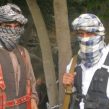
The IMU Expansion in Afghanistan’s Takhar Province: Jumping Off Point to Central Asia?
Publication: Eurasia Daily Monitor Volume: 10 Issue: 79
By:

While Helmand and other provinces in southern Afghanistan are the center of the Taliban insurgency and receive most media attention in the West, northern Afghanistan’s Takhar province has also come under increasing Taliban and Islamic Movement of Uzbekistan (IMU) influence since 2010 (taand.com, April 14). Given Takhar’s strategic location bordering Tajikistan, the province is the key conduit for drug trafficking from southern Afghanistan and Iran, through Central Asia, to Russia and Europe, which enriches Taliban and IMU commanders who facilitate the drug trade (ISAF Updates [Kabul] January 25, 2011; Khaama Press, February 23; Wakhtnewsagency [Takhar], April 8). Takhar province is also a staging point for the IMU to establish networks with militant groups operating in Tajikistan, such as the IMU affiliate Jamaat Ansarulah, after the United States and the North Atlantic Treaty Organization (NATO) withdraw most of their forces from Afghanistan in 2014 (Ferghananews.com, September 11).
In 2013, US and NATO forces have targeted the IMU in northern Afghanistan twice as frequently as they did in 2012, with approximately 20 operations in the first four months of 2013 alone. According to Afghan General Baba Jan, the commander of Pamir Zone 303, which includes Takhar and eight other provinces in northern Afghanistan, “Over the past three years, the presence of Uzbek militants has noticeably increased in northern Afghanistan” (Irib.in [Mashhad], April 14). Before the US invasion of Afghanistan in October 2001, the IMU was comprised mostly of Uzbeks from Uzbekistan, but now the IMU has foreign fighters in its ranks, including Tajiks, Kazakhs, Kyrgyz and Uighurs, as well as ethnic Uzbeks from northern Afghanistan (taand.com, April 14).
Nearly half of Afghanistan’s two-million ethnic Uzbeks live in Takhar Province. They were loyal to the Uzbekistan-supported General Abdul Rashid Dostum of the Northern Alliance from the start of Afghanistan’s civil war in the early 1990s until 1998, when Dostum’s forces were defeated and Dostum fled to Turkey. In January 2001, Takhar’s capital, Taloqan, became the last major city in northern Afghanistan to fall to the Taliban, leaving only northeastern Afghanistan’s Badakshan province under Northern Alliance control. Less than one year later, on September 9, 2001, Northern Alliance commander Ahmed Shah Massoud was assassinated five miles from the Tajikistan border in Khvajeh Bahaddin, Takhar Province by two Arab al-Qaeda members posing as foreign reporters.
Since 2010, Takhar’s historical connection to the Northern Alliance has waned, and increasing numbers of the province’s ethnic Uzbeks are joining the IMU. According to Mohammed Asim, a politician from Baghlan, northern Afghanistan, some of Takhar’s ethnic Uzbeks feel marginalized by the corruption and lack of Uzbek representation in Afghanistan’s primarily Pashtun and Tajik-led government, while other ethnic Uzbeks turned on the government after civilians were killed during battles between the Taliban and international or Afghan army forces (Asia Times, June 11, 2011; Afghanistan Analysts Network, May 25, 2011). Other government officials attribute the IMU’s recruiting success in Takhar to young ethnic Uzbeks from Takhar who, because of the lack of educational opportunities, travel to Pakistan for religious studies and return home influenced by the Taliban (Al-Jazeera [Taloqan, Takhar], April 10).
At the time same time, the ethnic Pashtun-dominated Taliban is aware of its limitations in northern Afghanistan and employs the IMU to recruit from northern Afghanistan’s non-Pashtun ethnic groups, while operating in small cells in remote areas to avoid US and NATO special forces (Al-Jazeera [Taloqan, Takhar], April 10). According to Afghan Deputy Defense Minister General Attiqullah Baryalai, since the death of the IMU’s founder Tahir Yuldash in a US drone strike in Pakistan in 2009, the militant group’s “ultimate prize” is Central Asia, which some IMU members felt Yuldash abandoned due to his support of the Taliban in Pakistan (Asia Times, July 11, 2011; Central Asia Online, August 9, 2011).
The seriousness of the IMU’s role in the insurgency in Takhar first became evident when a suicide bomber assassinated the predecessor of commander of Pamir Zone 303 General Baba Jan’s, General Mohammed Daud Daud, as well as the Takhar chief of police, the Takhar governor’s secretary, a security guard, and two German NATO soldiers at the Takhar governor’s headquarters on May 28, 2011 (Khaama Press, July 14, 2011). On June 1, an IMU commander who planned the attacks and directly reported to the IMU’s leadership in Pakistan’s Federally Administered Tribal Areas (FATA), was captured in northern Afghanistan’s Balkh Province (ISAF Updates [Kabul], June 1, 2011).
In December 2011, another IMU member carried out a suicide bombing in Takhar Province at a funeral procession of a government official, killing 19 people. One of the 19 casualties and the target of the attack was Alhaj Mutalib Beg, an ethnic Uzbek former Northern Alliance commander, who served as the chief of police of Takhar in 2004 and Kunduz in 2006. As in Pakistan, IMU fighters in northern Afghanistan have gained a reputation for their “ferocity” and willingness to carry out high-risk operations, often on orders from the Taliban to whom the IMU’s leadership has pledged loyalty, or bayaat, in return for the Taliban’s protection (Dawn, December 18, 2012).
Most recently, on April 9 and April 10, 2013, a bomb-making expert for both the Taliban and the IMU along with an IMU weapons distributor were captured by Afghan and international forces in Ishkashim, Takhar (ISAF Update [Kabul], April 10). In the following two weeks, Afghan and international forces carried out further raids on other IMU cells in the northern Afghanistan provinces of Baghlan and Samangan (ISAF Update [Kabul], April 10, April 19). The frequent arrests of IMU members and IMU attacks in northern Afghanistan thus show that the security risks in northern Afghanistan are likely as consequential for the future of Afghanistan and Central Asia as the risk of a Taliban resurgence in southern Afghanistan following the withdrawal in 2014.




